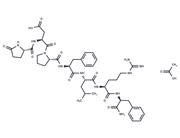| Name | Phe-Met-Arg-Phe, amide acetate |
| Description | Phe-Met-Arg-Phe, amide acetate, activates a K+ current in peptidergic caudodorsal neurons dose-dependently (ED50=23 nM) and appears to localize with neuropeptide Y in some brain regions. |
| In vitro | In the molluscan central nervous system, Phe-Met-Arg-Phe, amide (FMRFa) acts on K+ channels in sensory, motor-, and neuroendocrine neurons and activates a novel K+ current characterized by a combined voltage- and receptor-dependent gating mechanism, with both factors necessary for channel opening[1]. At 1 μM, it significantly inhibits glucose-stimulated (300 mg/dL) insulin release (p<0.005) and somatostatin release (p<0.01) from the isolated perfused pancreas. Phe-Met-Arg-Phe, amide (FMRF-NH2) (1 and 10 μM) has no effect on glucagon secretion, whether in low glucose (50 mg/dL), high glucose (300 mg/dL), or during arginine stimulation (5 mM)[2]. |
| In vivo | Phe-Met-Arg-Phe amide (FMRFamide) has been identified to stimulate growth hormone secretion in conscious ovariectomized (OVX) rats. Its immunoreactivity within hypothalamic neuronal elements hints at its involvement in regulating anterior pituitary functions. Administration of 200 ng (313.8 picomoles) of FMRFamide in a 2 uL volume significantly elevates plasma growth hormone (GH) levels within 15 minutes post-injection. Moreover, a dose range of 400-800 ng (627-1255 picomoles) of FMRFamide induces a rapid increase in GH levels, observable as early as 5 minutes and persisting for up to 30 minutes. |
| Storage | keep away from moisture | Powder: -20°C for 3 years | In solvent: -80°C for 1 year | Shipping with blue ice/Shipping at ambient temperature. |
| Solubility Information | DMSO : 10 mM, Sonication is recommended.
|
| Keywords | PotassiumChannel | Potassium Channel | Phe-Met-Arg-Phe, amide Acetate | PheMetArgPhe, amide acetate | Phe Met Arg Phe, amide acetate | K+ current (IKr) | 64190-70-1 freebase |
| Inhibitors Related | Minoxidil sulfate | Tannic acid | Hydrochlorothiazide | (±)-Naringenin | Tetraethylammonium bromide | Halothane | Butamben | Ursodeoxycholic acid | Cloperastine hydrochloride | Minoxidil | Nifedipine | Indapamide |
| Related Compound Libraries | Bioactive Compound Library | Pain-Related Compound Library | Membrane Protein-targeted Compound Library | Peptide Compound Library | NO PAINS Compound Library | Bioactive Compounds Library Max | Potassium Channel Targeted Library | Ion Channel Targeted Library | Anti-Cancer Compound Library |

 United States
United States






